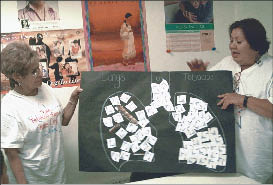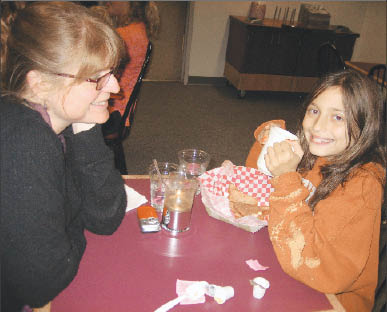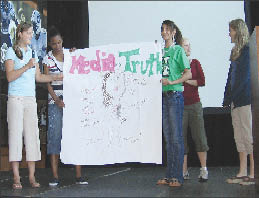 |
|
Dando Furenza a la Familia: Only one session focuses on substance abuse and its effect on the body.
|
Every now and then an advertising image is so powerful that it becomes a cultural icon – like the frying egg that stood for your brain.
In 1987, the Partnership for Drug-Free America launched the now-famous TV ad that starred an egg sizzling in a frying pan, while a baritone voice intoned: “This is your brain on drugs. Any questions?”
That piece of fright came at the tail end of the “Just Say No” era, the anti-drug campaign launched by first lady Nancy Reagan. Both phrases live on today as the butts of countless jokes, while the anti-drug strategies behind them have been largely abandoned.
“Large-scale media campaigns generally reinforce attitudes that are already established,” notes Liz Robertson, chief of the prevention research branch at the National Institute on Drug Abuse. “They don’t change people’s attitudes.”
“By junior high, 95 to 99 percent of the kids are well aware of the dangers” of drug abuse, says Gilbert Botvin, director of the Institute for Prevention Research at Weill Cornell Medical College and developer of the widely used Botvin Life Skills Training (LST).
Not only have anti-drug programs moved beyond biologically based scare tactics and morality-based media campaigns, but they’ve also moved beyond drugs. Many of today’s efforts are based on holistic approaches that focus on life skills and decision-making.
The efforts build on research into the myriad factors behind youth drug abuse, such as peers, family members and the media. Botvin, for instance, conceptualized LST after considering what skills youth need to help them deal with those factors: recognizing negative influences, resisting peer pressure and advertising messages, and building self-esteem, assertiveness and independent thinking. Like many newer anti-drug programs, LST spends little time actually discussing drugs.
Such approaches make sense to Arlene Terras, who served as research psychologist and study coordinator for the Multimodal Substance Abuse Prevention Program at the Philadelphia-based Belmont Center, which operated from 1995 until its federal funding ended in 2001.
“It hits the right notes,” Terras says. “You don’t treat adolescents who use drugs the way you treat addicts who use drugs. … There’s very, very, very little addiction” among youths.
“Most of the [youths’] problems trace back to family and psychological issues.”
The Neighborhood Houses in St. Louis switched to the life skills-oriented Sathya Sai curriculum, which originated in India, when an earlier program called “Be A Star” became outdated. Time seemed to have passed by both the materials – the stories, the music, the method of delivery (binders in a box, rather than software) – and the “Just Say No” content, says Program Director Roxanne Crawford. She says leaders of neighborhood community centers that used the program increasingly told her, “We can’t get much out of this. Times have changed.”
Sathya Sai, she says, is about choices: “Where do you want to be in life? What do you want to pursue? Many of them [the youths] say, ‘I want to be somebody. I don’t want to go to jail like my mom.’ ”
A similar shift in emphasis compelled administrators to change the name of Preparing for the Drug Free Years, developed at the University of Washington, to Guiding Good Choices, says Kevin Haggerty, assistant director of the university’s Social Development Research Group.
“The name change partly signifies … where we were in the late ’80s compared to where we are now,” he says, from “much more concern on drug use, per se” to “overall healthy development and healthy outcomes for young people. The name change reflects the zeitgeist.
“It also reflects what the program was originally designed to do: to promote positive outcomes, not just the absence of negative outcomes.”
While the emphasis of many such programs has changed, getting funds to keep programs going is no easier than ever. State grants through the U.S. Department of Education’s Safe and Drug-Free Schools program, which funds implementation, dropped from $555 million in 1997 to less than $300 million last year.
“Funding has diminished from what it was in the late ’90s,” says Haggerty of the Social Development Research Group. “It’s becoming more and more competitive at the local level” to find funds for anti-drug programs.
What’s more, much of the Safe and Drug-Free Schools money has gone to drug-testing programs, which have a “very meager deterrent effect,” says Linn Goldberg, a physician who led the creation of programs that focus on athletes and steroids, based at Oregon Health and Science University.
In addition, funding for research through the National Institutes for Health has flatlined for about four years, “barely keeping up with inflation,” Robertson says.
Following are examples of promising programs that have survived in the current climate. All are included on the National Registry of Evidence-based Programs and Practices (http://nrepp.samhsa.gov), run by the U.S. Substance Abuse and Mental Health Services Administration (SAMHSA). Due in part to funding cuts and to the shift in strategy away from pure anti-drug strategies, many of the programs on the list no longer exist.
Guiding Good Choices
Friends of Youth
Snoqualmie, Wash.
(800) 477-4776
www.channing-bete.com
www.friendsofyouth.org
 |
|
Guiding Good Choices, in Snoqualmie, Wash., lifts youth and adult spirits through discussions about managing family issues.
|
Approach: This five-session parenting curriculum helps those with children in fourth through eighth grades reduce risk factors for drug abuse, such as family management problems and conflict, rebelliousness and alienation, and friends who use drugs. Children usually attend the third session, which focuses on refusal skills, says Kevin Haggerty, assistant director of the Social Development Research Group at the University of Washington, which developed the curriculum.
Friends of Youth, one of many organizations that implement the program, took a slightly different approach, inviting children for the fifth session as well, says Phoebe Terhaar, chemical dependency prevention specialist. She says that immediately boosted the program’s completion rate from 50 percent to more than 90 percent. “That [session] seemed to be a draw of the program,” she says.
The program follows the social development model, in which parents meet in groups to develop skills for building family bonds and constructively managing anger, Haggerty says. “Those bonds are expected to inhibit problem behavior, because it’s more likely the kids will follow the standards and beliefs of the family,” he says.
The program encourages regular communication, parental warmth and affection, clear and pro-social expectations, consistent and moderate discipline, and consistent monitoring of children. Parents can talk and build networks with the other parents in each cohort, Haggerty says.
Friends of Youth partnered with Mount Si High School, where sessions are held, to bring counselors and child development teachers into the mix, Terhaar says. She says that because the school has a culinary arts program, dinner and child care can be provided, making it easier for parents to attend the sessions.
History: The curriculum began in elementary schools in 1982 as Preparing for the Drug Free Years, which included parent and teacher training, and became a stand-alone, parent-only program in 1987. After spreading to 87 sites in western Washington, the program began national dissemination in 1988. In 2000, the Channing Bete Co. bought the program, and brought co-developers and social work professors J. David Hawkins and Richard F. Catalano onto its staff.
Friends of Youth began its program in Snoqualmie, outside Seattle, six years ago and plans to expand to two other locations.
Youth Served: Friends of Youth has served 250 to 300 families, about 25 at a time, Terhaar says. “We’ve had to turn people away,” she says.
Haggerty estimates that overall, “hundreds of thousands” of people have participated in the curriculum at its many sites.
Staff: Channing Bete handles sales and marketing. The numbers and backgrounds of staff members vary from location to location. Friends of Youth employs two staffers, draws on school counselors, and invites parents who have completed the program to come back and mentor participating families.
Funding: Funding sources at various sites include federal Safe and Drug-Free Schools grants, county funds and small local grants. “One community uses liquor tax money,” Haggerty says. The program costs range from $12.99 for one “family guide” to $998 for a “leadership package” that includes 25 family guides and an instructional video.
The budget in Snoqualmie runs $3,000 to $5,000 for each set of sessions (covering food, child care, supplies and gift cards for volunteers) and is drawn primarily from a grant from the King County Alcohol and Other Drug Prevention Program, Terhaar says.
Indicators of Success: Follow-up studies have followed participants each year from sixth grade through high school, and have been published in such places as the Journal of Drug Education, Journal of Consulting and Clinical Psychology, Prevention Science and the Journal of Studies on Alcohol and Drugs.
A study in the clinical psychology journal showed that 10th-graders who had participated four years earlier showed 37 percent lower rates of marijuana use than those in a control group, 40.6 percent less alcohol use, 26 percent more likelihood of remaining drug-free and 54 percent less progression to more serious drugs. A cost-effectiveness study by the Washington State Institute for Public Policy found that every dollar spent in the program saved $11.07 in preventable costs, such as future treatment costs, crime, child abuse, juvenile rehabilitation and adult prison.
ATLAS/ATHENA
Oregon Health & Science University
(503) 494-8051
www.atlasprogram.com
www.athenaprogram.com
 |
|
Girls in an ATHENA program in Nashville, Tenn., show their campaign poster to fellow students.
|
Approach: These twin programs aimed at youth who play sports share common attributes but differ in ways that reflect the genders they target.
ATLAS (Athletes Training and Learning to Avoid Steroids), which started first, focuses on boys’ use of steroids and other performance-enhancing drugs, but includes material about abuse of other illegal drugs and alcohol.
ATHENA (Athletes Targeting Healthy Exercise and Nutrition Alternatives) is tailored to girls. An assessment conducted at the outset of ATHENA showed that young women who said they could imagine using steroids were more likely to be depressed, have eating disorders and use weight-loss methods like diuretics, says Linn Goldberg, a physician who founded the two programs at the Division of Health Promotion and Sports Medicine, based at Oregon Health & Science University.
“They often think that the thinner they are, the faster and more athletic they’ll be,” he says. “We knew we would have to have a depression prevention part of the program as well as a nutrition arm.”
Both programs focus on sports nutrition and state-of-the-art strength training, Goldberg says. But when it comes to eating, the approaches diverge.
“Men, we … give them formulas for calories, formulas for proteins,” he says. “They eat everything. We teach them what to eat.” Male participants receive a small booklet with “winner meals” and “loser meals” at fast-food restaurants.
With young women, however, “We never talk about calories,” Goldberg says. “All those programs that talk about calories can lead to caloric restrictions, which exacerbate disordered eating. We do talk about calcium and protein.”
Both programs are taught in small groups, with the team’s coach setting the process in motion but youth “squad leaders” heading up smaller groups to participate in interactive activities, such as games and puzzles. “A lot of [the material] is written with humor,” Goldberg says.
The program is used with high school, club and recreation league teams, as well as in health classes. The weekly 45-minute sessions last for 10 weeks for ATLAS and eight weeks for ATHENA. Toward the end, the youths create public service announcements to present to their teams, promoting nutrition, strength training and avoiding steroids.
“It’s stuff we could never write. It’s very germane to the site,” Goldberg says. “It’s kids teaching kids.”
Sports Illustrated and the National Football League sponsor programs at some of the schools involved. Other schools approach Goldberg’s division to purchase the materials. “It’s pretty much turn-key,” he says. “A coach can train a squad leader in 90 minutes.”
History: Goldberg and his colleagues started studying steroids in 1987 and began ATLAS in 1991 with a grant from the National Institute on Drug Abuse. They had found that scare tactics actually boosted athletes’ interest in steroids, but peer education had the reverse effect. The institute initially wanted to focus on funding a boys program, but later agreed to include girls.
Youth Served: The program has been purchased by or donated to about 165 high schools. Some 15,000 youth have been reached in the 31 schools sponsored by Sports Illustrated, and another 20,000 through the NFL programs. Goldberg doesn’t keep track of how many programs participate without that support.
Staff: Five core university staff, including Goldberg, run the program.
Funding: The curricula for ATLAS and ATHENA are produced to order and include an athlete’s guide for every student at $11 per copy, along with one squad leader manual for every five students, and a coach’s package for $280. Thirty-seven high schools in NFL cities receive funding from the league for the program.
Indicators of Success: The Center for Health Promotion Research has found promising results among 3,200 athletes in ATLAS. A study published in 1996 in the Journal of the American Medical Association found that one year after participation, the youths’ use of steroids and other athletic supplements fell about 50 percent, illicit drug use fell about 50 percent, and the drinking-and-driving rate dropped 24 percent.
Another study, involving 928 youths from 40 teams in ATHENA, found that “athletes reported significantly less ongoing and new use of diet pills and less use of athletic-enhancing substances.” That study, published in the November 2004 Archives of Pediatrics & Adolescent Medicine, noted that “reductions occurred in intentions toward future use of diet pills, vomiting to lose weight, and use of tobacco and muscle-building supplements.”
Sathya Sai Education in Human Values
Neighborhood Houses
St. Louis, Mo.
(314) 383-1733
www.neighborhoodhouses.org
Approach: Sathya Sai sounds a little New Age-ish. Imported from India, the program focuses on prevention and character-building by drawing from five principles: love, peace, right action, truth and nonviolence. The curriculum comes with lesson plans that incorporate singing and “silent sitting,” a form of meditation, says Roxanne Crawford, director of programs.
“We turn the lights off, play music, ask kids to center themselves, [tell] a lot of stories based on morals and values,” she says.
Because many of the participants see the ill effects of drug abuse in their homes and communities, Sathya Sai has no lesson plan to teach them about it. “There’s not a unit on drugs, and ‘say no to drugs,’ and all that campaigning and such,” Crawford says. “We talk about it when it arises.
“Kids today, they know. They have parents who are possibly addicted and incarcerated. … Some of them are in the foster care system because mom was using.”
Instead, she says, the curriculum stresses such fundamental character traits as “being honest, supporting your neighbor. We’re hoping that by instilling morals, kids will make the right choices.”
If it seems a bit square, Neighborhood Houses provide a safe space for youths to interact and support one another without fear of peer reprisals, Crawford says. The program is carried out at Neighborhood Houses’ three community centers and at four schools.
“They won’t be bullied,” she says. “What’s said here, stays here – a lot of talk and rap sessions in supporting one another. They come to us for refuge.”
The program weaves in art, drama and other activities. “If they’re into the spoken word, or if they’re into T-shirt-making, messages on your shirts,” then the youth workers find ways to carry that out, Crawford says.
History: Neighborhood Houses is a 95-year-old nonprofit that runs a range of programs, including parenting, day care and after-school. About five years ago, Neighborhood Houses switched to Sathya Sai from an earlier, more “just-say-no” type of curriculum called “Be A Star.” The agency learned about Sathya Sai from Doris Hampton, a St. Louis-area resident who adapted the curriculum, which originated in India, for use in the United States. Sathya Sai is offered by the Sathya Sai Organization through the nonprofit SSEHV Foundation (www.ssehvusa.org).
Youth Served: The program can serve up to 450 fifth- and sixth-graders in seven locations. Most are from St. Louis public schools in “hard-pressed neighborhoods,” Crawford says. Hampton says about 8,000 youth in 13 states have participated in Sathya Sai.
Staff: Neighborhood Houses employs 57 part-time and 24 full-time staffers. Most are educators or social workers. The principles of Sathya Sai are infused through all of the agency’s programs.
Funding: The agency’s annual budget is about $1.7 million. Sathya Sai is “the most affordable curriculum on the planet,” Crawford says, at about $20 for each set of materials, which covers one site.
Indicators of Success: Neighborhood Houses just began evaluating Sathya Sai. With help from university researchers, Crawford and her staff have devised a social skills evaluation that was implemented last fall and measures work habits, ability to compromise, ability to accept constructive criticism without becoming angry and skills to cope with aggression. It does not cover skills directly related to avoiding drug use, because that’s not the focus of Sathya Sai. Results should be ready at the end of the school year.
Dando Fuerza a la Familia
Aliviane Inc.
El Paso, Texas
(915) 782-4032
jpriego@aliviane.org
www.aliviane.org/dando.html
Approach: Aimed at families in which at least one parent has been a substance abuser, Dando Fuerza is carried out in weekly two-hour sessions for 14 weeks. During the first hour, parents and children (ages 6 to 11) split into different rooms, where facilitators help them talk about life skills and how to apply those skills with their children and peers. The groups join in the second hour.
“It’s all positive. We’re not attacking the parents,” says Ivonne Tapia, clinical deputy director. “It’s about social skills, problem-solving skills, coping skills, how to have a conversation and how to listen, how to understand commands and directions, how to cope with fear, how to ask for help.”
Only one session specifically addresses substance abuse, Tapia says. “We all know it’s more than just, ‘Here’s the problem with drugs, and here’s what they can do,’ ” she says. “We target those risky behaviors that tend to lead people into substance abuse.”
Youths with parents who abuse drugs might not be able to talk with them about things like coping skills and recognizing feelings, Tapia says, but staffers encourage them to look beyond the families. “Maybe there’s a grandmother. Maybe there’s a neighbor. Maybe there’s a teacher,” she says. “One of the things we teach them is they can’t change their parents. They can only change themselves.
“But we keep it positive. They still love their parents.”
The second hour of each of the sessions uses role-playing and hands-on activities to reinforce what the parents and children have learned, Tapia says. For example, to teach parents how to enforce household rules – and teach children how to follow them – they work collaboratively on a chore and behavior chart.
The families sometimes gather outside of the formal sessions for potluck dinners and outings to museums and amusement parks, for which the program pays admission fees.
Dando Fuerza was developed to serve one parent with one elementary school-aged child, but Aliviane has adapted the program for its largely Hispanic population, Tapia says. “You can’t say to a Hispanic family, ‘Only one parent and one child,’ ” she says. “Maybe there’s only one parent, but maybe there’s a grandparent or aunt or uncle. We welcome the whole family to attend – whoever’s involved with these children.”
The program runs five nights a week in two community centers: one centrally located in El Paso and the other in a rural area.
History: The nonprofit Aliviane has provided substance abuse treatment and prevention services, as well as mental health services, for more than 37 years, Tapia says. It received a SAMHSA grant in 1998 to provide services for children of substance-abusing parents; that program has expanded to serve families considered “at risk” of abuse.
Youth Served: The program serves up to 70 families at a time in three sessions per year. At least 80 percent are low-income Hispanics, Tapia says.
Staff: Five full-timers and three-part timers, all of whom have backgrounds in substance abuse counseling and prevention. Some have bachelor’s or associate’s degrees, and some simply have “many years of experience,” Tapia says. All are working to become certified prevention specialists.
Funding: Originally funded through SAMHSA, Dando Fuerza now receives its $350,000 annual appropriation from the Texas Department of State Health Services.
Indicators of Success: Before-and-after data collected by outside evaluator Gustavo Martinez, covering 1998 to 2002, showed that participating children increased their school attendance and performance, were better able to identify and express their feelings, felt more bonded with their parents, and enjoyed “a significant increase in their knowledge of substance abuse and the consequences,” Tapia says. Data were collected 14 weeks, six months and one year after program completion, she says.

































